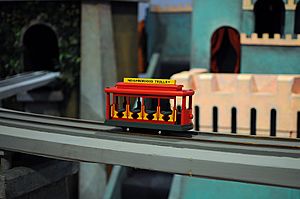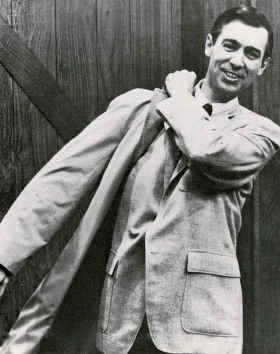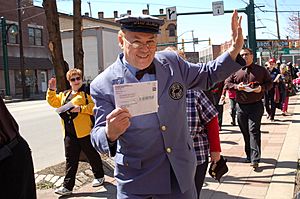Mister Rogers' Neighborhood facts for kids
Quick facts for kids Mister Rogers' Neighborhood |
|
|---|---|
 |
|
| Genre |
|
| Created by | Fred Rogers |
| Starring |
|
| Theme music composer | Fred Rogers |
| Opening theme | "Won't You Be My Neighbor?" |
| Ending theme |
|
| Composer(s) |
|
| Country of origin | United States |
| Original language(s) | English; some episodes feature DVS via SAP |
| No. of seasons | 31 |
| No. of episodes | 912 (including specials) |
| Production | |
| Production location(s) | WQED Studios Pittsburgh, Pennsylvania |
| Camera setup | Single camera (1968–1992), Multi-camera (1992–2001) |
| Running time | 28 minutes |
| Production company(s) |
|
| Distributor | American Public Television |
| Release | |
| Original network | |
| Picture format | 480i SDTV |
| Audio format | Mono (1968–1989) Stereo (1989–2001) |
| Original release | February 19, 1968 – August 31, 2001 |
| Chronology | |
| Followed by | Daniel Tiger's Neighborhood |
Mister Rogers' Neighborhood (sometimes shortened to Mister Rogers) is an American half-hour educational children's television series that was created and hosted by Fred Rogers. The series Misterogers debuted in Canada on October 15, 1962, on CBC Television. In 1966, Rogers moved back to the United States creating Misterogers' Neighborhood (sometimes shown as MisteRogers' Neighborhood), later called Mister Rogers' Neighborhood, on the regional Eastern Educational Television Network (EETN, a forerunner of today's American Public Television). The US national debut of the show occurred on February 19, 1968. It aired on NET and its successor, PBS, until August 31, 2001.
The series is aimed primarily at preschool children ages 2 to 5, but it was labelled by PBS as "appropriate for all ages". Mister Rogers' Neighborhood was produced by Pittsburgh, Pennsylvania public broadcaster WQED and Rogers' non-profit production company Family Communications, Inc., previously known as Small World Enterprises prior to 1971; the company was renamed The Fred Rogers Company after Rogers' death (it has since been renamed again to Fred Rogers Productions as of 2019). In May 1997, the series surpassed Captain Kangaroo as the longest-running children's television series, a record the series held until June 2003, when Sesame Street beat Mister Rogers' record. The series could be seen in reruns on most PBS stations until August 31, 2007, when it began to be removed by various PBS stations, and was then permanently removed from the daily syndicated schedule by PBS after August 29, 2008.
Eleven years after Mister Rogers' Neighborhood concluded, PBS debuted an animated spin-off, Daniel Tiger's Neighborhood. A 50th-anniversary tribute show, hosted by actor Michael Keaton (who got his start on the show), titled Mister Rogers: It's You I Like, premiered on PBS stations nationwide on March 6, 2018.
Contents
History
The series had its genesis in 1953, when Rogers and Josie Carey joined the newly formed public television station WQED. On April 5, 1954, WQED debuted The Children's Corner, a program featuring Rogers as puppeteer and composer with Carey as host and lyricist, in an unscripted weekday afternoon live television program. It was this program where many of the puppets, characters and music used in the later series were developed, such as King Friday XIII, Daniel Tiger, and X the Owl. It was also the time when Rogers began wearing his famous sneakers, as he found them to be quieter than his work shoes while he was moving about behind the set. The show won a Sylvania Award for best children's show, and was briefly broadcast nationally on the NBC Television Network.
CBC Television
Rogers moved to Toronto, Ontario, in 1961 to work on a new series based on The Children's Corner, called Misterogers, a 15-minute program on CBC Television. Misterogers aired on CBC for about four years and a number of the set pieces that he would take with him back to the United States, such as the trolley and castle, were created for the Canadian program by CBC designers and in collaboration with producer Bruce Attridge. Most importantly, Rogers appeared on camera in the new show rather than only appearing through puppets or characters. Fred Rainsberry, head of Children's Programming at CBC, persuaded Rogers to appear on camera in the new show (which he named after Rogers) after seeing him interact with children. Ernie Coombs, one of the Americans whom Rogers brought with him to help develop the CBC show, would remain with CBC after Rogers returned to the United States. Coombs first appeared as Mr. Dressup in the CBC program Butternut Square, conceived and produced by Attridge. Coombs then helped to develop what became Mr. Dressup which ran for nearly 30 years, ending in 1996.
Move to WQED
In 1966, Rogers acquired the rights to his program from CBC and moved the show to WQED in Pittsburgh, where he had worked on The Children's Corner. He renamed the show Misterogers' Neighborhood, which initially aired regionally in the northeastern US through EEN, including educational stations in Boston, Washington, D.C., and New York City. The 100 episodes of the half-hour show incorporated the "Neighborhood of Make-Believe" segments from the CBC episodes with additional reality-based opening and closing material produced in Pittsburgh. The series was cancelled in 1967 due to lack of funding, but an outpouring of public response prompted a search for new funding.
In 1967, The Sears Roebuck Foundation provided funding for the program, which enabled it to be seen nationwide on National Educational Television; taping began on September 21, 1967 for the first national season. The first national broadcast of Misterogers' Neighborhood appeared on most NET stations on February 19, 1968. In 1970, when PBS replaced NET, it also inherited this program. Around the same time the show had a slight title change, to the more-familiar Mister Rogers' Neighborhood.
The show was broadcast from February 19, 1968 to February 20, 1976, and again from August 20, 1979 to August 31, 2001. The final episode was taped on December 1, 2000. The studio at WQED in Pittsburgh where the series was taped was later renamed "The Fred Rogers Studio".
Format
During each half-hour segment, Rogers speaks directly to the viewer about various topics, taking the viewer on tours of factories, demonstrating experiments, crafts, and music, and interacting with his friends. Rogers also made a point to simply behave naturally on camera rather than acting out a character, stating that "One of the greatest gifts you can give anybody is the gift of your honest self. I also believe that kids can spot a phony a mile away." The half-hour episodes were punctuated by a puppet segment chronicling occurrences in the Neighborhood of Make-Believe. Another segment of the show consisted of Rogers going to different places around the neighborhood, where he interviews people to talk about their work and other contributions that focused on the episode's theme, such as Brockett's Bakery, Bob Trow's Workshop, and Negri's Music Shop. In one episode, Rogers took the show behind-the-scenes on the set of The Incredible Hulk, which aired on CBS from 1978 to 1982.
At the start of each episode, the show's logo appears as the camera pans slowly over a model of the neighborhood, while the "Neighborhood Trolley" crosses several streets from left to right as the text reads "Mister Rogers Talks About...", as the camera goes from the neighborhood to inside the Rogers' television house. From 1979 to 1981, an alternate version of the opening sequence was used. Usually, the camera goes from the neighborhood to out on the porch of the Rogers' television house, where the viewers see Fred Rogers coming for a visit before he enters the house. This is the same model electric trolley that later in the program will transport viewers into the Neighborhood of Make-Believe. After the camera goes from the neighborhood to inside the Rogers' television house, Fred Rogers is seen coming home with his jacket on, singing "Won't You Be My Neighbor?". He goes into the closet, takes off his jacket, hangs it up, and grabs a cardigan zipper sweater to put on. After that, he takes his dress shoes off and grabs a pair of blue sneakers to put on. One of Rogers' sweaters now hangs in the Smithsonian Institution, a testament to the cultural influence of his simple daily ritual.
At the end of each episode, Rogers sang "It's Such a Good Feeling" (a different song, "Tomorrow" was used from 1968–72) when he took off his sneakers as he says "You're alive" in a higher toned voice, and grabs his dress shoes to put back on, and then snaps his fingers two times. After that, Rogers goes into the closet, takes off his cardigan, hangs it up, and grabs his jacket to put back on. Before the closing credits, Rogers got ready to go out the door by reminding the viewers: "You always make each day a special day. You know how: By just your being you/yourself. There's only one person in the whole world that's like you, and that's you. And people can like you just/exactly the way you are. I'll be back next time. Bye-bye!". During the closing credits, which is complete with the show's logo and the episode number, the camera would perform a reversed version of the opening sequence's pan shot, while the "Neighborhood Trolley" crosses streets from right to left.
Starting in 1979, episodes were grouped into week-long series, with each series focused on a particular topic. Rogers' monologues throughout the week explore various facets of the topic, and the ongoing story from the Neighborhood of Make-Believe serves as illustration.
Rogers covered a broad range of topics over the years, and the series did not shy away from issues that other children's programming avoided. In fact, Rogers endeared himself to many when, on March 23, 1970, he dealt with the death of one of his pet goldfish. The series also dealt with competition, divorce, and war. Rogers returned to the topic of anger regularly and focused on peaceful ways of dealing with angry feelings.
Beginning in the third season, Mister Rogers always made a clear distinction between the realistic world of his television neighborhood and the fantasy world of Make-Believe (prior to that, the line was blurred somewhat as he would often talk about it as if it were real and he had a direct line of contact with the characters in it). He often discussed what was going to happen in Make-Believe before the next fantasy segment was shown ("Let's pretend that Prince Tuesday has been having scary dreams..."), and sometimes acted out bits of Make-Believe with models on a table before the camera transitioned to the live-action puppet rendition. The miniature motorized trolley, which was known in character form as "Trolley", with its accompanying fast-paced piano theme music, was the only element that appeared regularly in both the realistic world and Make-Believe: it was used to transport viewers from one realm to the other. Rogers, however, was mentioned from time to time in Make-Believe, particularly by Mr. McFeely, who appeared occasionally in the Make-Believe segments and seemed to form a link between the two worlds. The idea of the trolley came from Rogers. When he was young, many trolleys operated in Pittsburgh, and he liked riding on them. This reality/fantasy distinction put Rogers' series in sharp contrast with other children's series, such as Sesame Street and Captain Kangaroo, which freely mixed realistic and fantastic elements.
Trolley was a character in its own right. Often when it crossed into the Neighborhood of Make Believe, it would stop and have a "conversation" with King Friday XIII (by moving back and forth slightly and making bell noises to respond to Friday) then continue on. Trolley also truly showed the difference between the worlds during the week when the three youngest puppet characters (Daniel Striped Tiger, Prince Tuesday, and Ana Platypus) prepared for and went to school for the first time, as it played the school bus. When in Mister Rogers' house, it simply had two pieces of yellow construction paper shaped and drawn like the profile of a school bus stuck to its sides, but in the Neighborhood of Make-Believe, it had a chassis on it that made it look like a school bus.
The series featured "Picture Picture", a rear-projection motion picture and slide projector, whose screen is encased with a picture frame. In early episodes, Picture Picture would show various films or slides at Mister Rogers' command; after the material was presented, Mister Rogers would thank Picture Picture, to which it would return a "You're Welcome" on its screen. After 1970, Picture Picture no longer operated magically, becoming merely a projector; Mister Rogers would insert a film, slides or videotape through a slot on the side, then show the material using a wired remote control. When Picture Picture was not used, a different painting would be displayed on its screen. Often it would display the words "Hello" or "Hi" at the opening.
The series was also notable for its use of jazz-inspired music, mostly arranged and performed by Johnny Costa, until Costa's death in 1996, when he was succeeded by Michael Moricz for the remainder of the series. The music was unique in its simplicity and flow that blended with the series' sketches and features. The music was usually played live during taping. Lyrics and melodies were written and sung by Rogers, who created more than 200 original songs.
Characters
Mister Rogers' Neighborhood
Characters on the series include:
- Neighbor Aber (Chuck Aber) - A resident of Westwood who is an associate of Mayor Maggie and does a lot of odd jobs. His real world counterpart also does odd jobs.
- Lady Aberlin (Betty Aberlin) - The niece of King Friday XIII. Her real-world counterpart Betty is an actress who is the manager of Betty's Little Theater.
- Scientist Adler (Bud Adler) - A scientist who offers his scientific expertise in the real world and the Neighborhood of Make-Believe in earlier episodes.
- Charles Appel - A teacher and magician who is a friend of Mr. Rogers.
- Natalie Baker - The cousin of Joe Negri and mother of Angela and Reid who is a piano-playing teacher.
- Marilyn Barnett - The gym teacher at the neighborhood school.
- Chef Brockett (Don Brockett) - A baker who owns Brocket's Bakery. His Neighborhood of Make-Believe counterpart assists Edgar Cooke in the kitchen.
- Bob Brown - A puppeteer and marionette maker who is proprietor of Bob's Marionette Theater which is next door to Mr. Rogers' house.
- Judy Brown - The wife of Bob and co-proprietor of Bob's Marionette Theater.
- Michael Brown - The son of Bob and Judy Brown.
- Tony Chiroldes - The proprietor of the shop "Tony's" which specializes in toys, books, and costumes.
- Jose Cisneros - An employee at Brocket's Bakery and cousin of Gladys Schenk who operates the counter and soda shop. He started working at Brocket Bakery after Gladys had a baby.
- Officer Clemmons (François Clemmons) - A police officer who is a trained opera singer.
- Dr. David Crippens - The neighborhood doctor.
- Keith David - In the Neighborhood of Make-Believe, he is a carpenter who lives in Southwood. His real world counterpart appears in episode 1514 where he collects the money from the Donkey Kong arcade game at Brockett's Bakery.
- Emily the Poetry Lady (Emily Jacobson) - She appeared in early episodes.
- Joey Hollingsworth - A tap dancer who shares his talents in the "real" world and the Neighborhood of Make-Believe.
- Pilot Ito (Yoshi Ito) - An opera singer who serves as the royal pilot of King Friday XIII.
- Susan Linn - A local puppeteer who often makes up stories that involve Audrey Duck and Catalion at Betty's Little Theater.
- Mayor Maggie (Maggie Stewart) - The Mayor of Westwood. Her real world counterpart Maggie is an expert at sign language.
- Mr. McFeely (David Newell) - The delivery man for "Speedy Delivery" who was a frequent visitor to Mr. Rogers' house. He was named for Fred Rogers' maternal grandfather.
- Mrs. McFeely (Betsy Nadas) - The wife of Mr. McFeely.
- Elsie Neal - A woman who operates the neighborhood craft and costume shop.
- Debbie Neal - The daughter of Elsie Neal and an excellent singer who works at Negri's Music Shop.
- Handyman Negri (Joe Negri) - A jazz-guitarist who has taught music at several Pittsburgh universities. His real world counterpart Joe operates the musical-instrument shop called Negri's Music Shop on Rogers's street.
- Miss Paulificate (Audrey Roth) - The royal telephone operator. Her real-world counterpart Audrey operates a janitorial service called Audrey Cleans Everything, where her mobile home serves as her office.
- Sergio Pinto - An employer at Brockett's Bakery who runs the counter and would teach some Spanish words to Mr. Rogers.
- Mary Rawson - She shows interest in the theater and mime at "Betty's Little Theater."
- John Reardon - An opera singer and frequent visitor of the Neighborhood of Make-Believe who helps its residents write and perform various operas.
- Gladys Schenk - A mother of two and an employee at Brockett's Bakery and cousin of Jose Cisneros.
- Chrissy Thompson - The granddaughter of Mr. McFeely and Mrs. McFeely. She has spina bifida which requires her to use leg braces and openly talks about it.
- Bob Trow - He runs Trow's Workshop where he works as a craftsman. It is at Trow's Workshop that Bob creates and fixes things for Mister Rogers and his fellow neighbors.
- Jewel Walker - A mime artist.
Only Mr. McFeely, Mrs. McFeely, Officer Clemons, Scientist Adler, and Chef Brockett appeared substantially the same way in both Mr. Rogers' Neighborhood and the Neighborhood of Make-Believe.
Neighborhood of Make-Believe
The "Neighborhood of Make-Believe" is the fictional kingdom visited by Mr. Rogers during the show. Characters in the Neighborhood of Make-Believe were portrayed by both hand puppets and actors. Fred Rogers was the puppeteer for a great number of the characters:
- Collette
- Cornflake S. Pecially
- Daniel Stripèd Tiger
- Donkey Hodie
- Edgar Cooke
- Grandpère Tiger
- Henrietta Pussycat
- Ino A. Horse
- King Friday XIII
- Lady Elaine Fairchilde
- Mrs. Frogg
- Princess Margeret H. Lizard
- Queen Sara Saturday
- Tadpole Frogg
- X the Owl
Other characters and their performers or puppeteers:
- Anna Platypus
- Betty Okonak Templeton-Jones
- Bob Dog
- Cousin Mary Owl
- Cousin Steven Owl
- Dr. Duckbill Platypus
- Elsie Jean Platypus
- Harriett Elizabeth Cow
- H.J. Elephant III
- Hula Mouse
- James Michael Jones
- Prince Tuesday
- Purple Panda
- Robert Troll
In addition to Bob Trow other regular puppeteers included Michael Horton, Lenny Meledandri (1980–2001), and Carole Switala.
Michael Keaton made his first television role as a volunteer in 1975. He played an acrobat in a troupe called The Flying Zookeenies that performed for King Friday's birthday and was also in charge of running the Trolley.
Operas
Thirteen in-series "operas" took place during the course of the series within the Make-Believe segments. Many of them featured American baritone John Reardon as a main character. The operas would encompass the entire episode and would be seen after a brief introduction by Mr. Rogers.
- Babysitter Opera (1968)
- Campsite Opera (1968)
- Teddy Bear/Whaling Ship Opera (1969)
- "Pineapples and Tomatoes" (1970)
- "Monkey's Uncle" (1971)
- "Snow People and Warm Pussycat" (1972)
- "Potato Bugs and Cows" (1973)
- "All in the Laundry" (1974)
- "Key to Otherland" (1975)
- "Windstorm in Bubbleland" (1980)
- "Spoon Mountain" (1982)
- "A Granddad for Daniel" (1984)
- "A Star for Kitty" (1986)
Additionally, a play, Josephine The Short-Necked Giraffe, first aired in 1989 as a tribute to the late John Reardon.
Guests
Guests on the series ranged from cellist Yo-Yo Ma to actor and bodybuilder Lou Ferrigno of TV's The Incredible Hulk (in a 2001 piece where celebrities were asked about their heroes, Rogers cited Ma as one of his heroes). A 1968 visit by electronic music pioneer Bruce Haack resurfaced in the 2004 documentary Haack: King of Techno.
Guests on Mister Rogers' Neighborhood were often surprised to find that although Rogers was just as gentle and patient in life as on television, he was nevertheless a perfectionist who did not allow "shoddy" ad-libbing; he believed that children were thoughtful people who deserved programming as good as anything produced for adults on television.
Rogers appeared as a guest on some other series. On the children's animated cartoon series Arthur, for example, Rogers plays himself as an aardvark like Arthur. Later on, Arthur appears as a guest in hand-puppet form in a 1999 episode of Mister Rogers' Neighborhood in the Neighborhood of Make-Believe. Bill Nye, host of a science-themed program, and Rogers also exchanged appearances on each other's series, as did Rogers and Captain Kangaroo. Rogers additionally appeared in an episode of Sesame Street, where he explains to Big Bird that even if one loses a running race such as the one Big Bird had run against his friend "Snuffy", no hard feelings threaten to break the two of them apart. Big Bird himself also appeared in one episode of Mister Rogers' Neighborhood in the Neighborhood of Make-Believe when he came to deliver his entry to the "Draw the Neighborhood" art contest.
See also
 In Spanish: Mister Rogers' Neighborhood para niños
In Spanish: Mister Rogers' Neighborhood para niños




